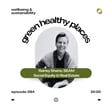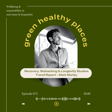Become a Creator today!Start creating today - Share your story with the world!
Start for free
00:00:00
00:00:01

GHP 087: Learn Biomimicry with Jess Berliner
Welcome to episode 87 of the Green Healthy Places podcast, in which we explore the themes of well-being and sustainability in the built environment.
I'm your host, Matt Morley, and we're delighted to be back after an unavoidable break with another series of concise, practical conversations from inspiring figures around the world.
This week, we're in Cape Town, South Africa, talking to Jess Berliner, co-founder and director of product of Learn Biomimicry.
Over the last six years, Jess has co-authored all of her company's learning products, short courses, six-month mental programs, and e-books.
She's a self-professed nature nerd and scuba diver. So who else better to talk us through the topic of biomimicry?
LINKS:
Transcript
Introduction to Episode 87
00:00:06
Green Healthy Places
Welcome to episode 87 of the Green Healthy Places podcast, in which we explore the themes of well-being and sustainability in the built environment. I'm your host, Matt Morley, and we're delighted to be back after an unavoidable break with another series of concise, practical conversations from inspiring figures around the world.
Meet Jess Berliner and Her Biomimicry Journey
00:00:27
Green Healthy Places
This week, we're in Cape Town, South Africa, talking to Jess Berliner, co-founder and director of product of Learn Biomimicry. Over the last six years, Jess has co-authored all of her company's learning products, short courses, six-month mentor programs, and e-books.
00:00:44
Green Healthy Places
She's a self-professed nature nerd, a scuba diver. So who else better to talk us through the topic of biomimicry? Jess, welcome to the show. Great to have you with us.
00:00:54
Jess Berliner
Thank you so much, Matt. It's great to be here.
00:00:57
Green Healthy Places
Let's jump in. Why
What is Biomimicry?
00:00:58
Green Healthy Places
don't we start by explaining what biomimicry is for the uninitiated, but also thinking about how it can be used and applied in the real world and therefore in a way who it's most relevant to.
00:01:11
Jess Berliner
Amazing. So yeah, let's start right at the very beginning, right? So biomimicry can be quite a mouthful as a word. And when we break it down into its simplest components, we've got bio meaning life and mimicry or mimic meaning to actually imitate.
00:01:25
Jess Berliner
And you could really define biomimicry as innovation inspired by nature. And that is really how it is most broadly understood. and We can take a step further and actually call it the conscious emulation of nature's genius. And maybe later on we can kind of get into that.
Biomimicry's Influence on Design and Engineering
00:01:42
Jess Berliner
But really that is where it starts, is looking to nature so we can actually learn from it instead of just about it. So you know until now, at least in westernized sort of societies, we've had this very kind of knowing about nature view. We know all about things, we've given them all names, we've got loads of data, but we haven't really stopped to actually think about What might we learn from it?
00:02:05
Jess Berliner
And so that's the major kind of perspective shift here that biomimicry brings to us. And then as to you know where is it applied? This is tricky because kind of everywhere and anywhere, I think maybe if I could jump into where it's most impactful.
00:02:21
Jess Berliner
i am I do strongly believe that biomimicry is incredibly impactful in spaces such as the built environment. especially in things like materials engineering as well and then yeah really kind of in the design and engineering world it is very very relevant in terms of exact design methodology there it also and again we can get into this but it really asks like a nice sort of philosophical shift of us as well in terms of and in the businesses that we're running and the kinds of businesses that we want to create, the kind of spaces that we want to create, and who we're really building for. So on the practical design side, really design engineering, chemical engineering, textiles, built environment, you name it,
00:03:05
Jess Berliner
And then really on the business side and the philosophical side, we kind of get more into bigger questions around how I might design that. So at its very core, biomimicry is a sort of a mindset and a methodology that really brings life into the center of the conversation.
00:03:23
Jess Berliner
So instead of you know design being very human centric, it becomes bigger than that to being life centric and life friendly.
00:03:31
Green Healthy Places
So how
Biophilic Design vs. Biomimicry
00:03:32
Green Healthy Places
would you distinguish then between concept that's perhaps slightly more better known, or that at least on this podcast, we've spoken about more often in the past, which would be biophilic design.
00:03:43
Green Healthy Places
So nature inspired design or interiors to bring the outside world in. is it Would that almost be a subset of biomimicry? you see it as being sort of one macro, one micro, are they some two sides of the same coin in your mind?
00:04:00
Jess Berliner
Good question. So
The Three M's of Biomimicry
00:04:01
Jess Berliner
I think that they are they're related. They're in the same kind of general species of design, but they're not the same thing. So biophilic design, and my understanding, is really you know bringing the living world into our buildings and kind of bringing us closer back to nature in terms of like you know the proximity and you know what we choose to include in our built environment in terms of sort of plants and these living elements.
00:04:29
Jess Berliner
Whereas biomimicry, as i was mentioning, is more this kind of conscious emulation of nature's genius. and Maybe if I unpack that, that will help to kind of distinguish them a little bit more. So when we're emulating, we're not just copying directly, we're not using biology necessarily, which is kind of more in that bio-utilization space, but we're emulating it. And so this means that we're learning from the mechanisms and the strategies that nature holds and then actually abstracting and applying that to our design. that is the emulation.
00:05:00
Jess Berliner
And then the conscious part of it is really being very deliberate about this. So it is not just a kind of slap dash, oh, this looks like a bird's nest, therefore it is biomimicry. It is really kind of going deeper and going like,
00:05:13
Jess Berliner
is this actually life-centric? What am I doing to really make this more regenerative instead of just going, oh, it looks kind of like that. So biomorphic means it just looks like something na natural, but it doesn't really go beyond that. you know And so really biomimicry brings us into more of a deliberate emulation as opposed to just an inclusion, if that makes more sense.
00:05:37
Green Healthy Places
It does, yeah. and
Learning and Applying Biomimicry
00:05:38
Green Healthy Places
So obviously, to provide a bit more context for for listeners, you're providing courses on this subject, you're theorizing on the topic. And I often find with with someone who's involved in the theory, as well as the practice, they get good at creating things as models and methodology. And I saw one mentioned on your website that has the three N's that caught my attention around modeling, measuring, and mentoring. So can you just talk us through how how that relates to sort of biomimic rethinking?
00:06:08
Jess Berliner
Absolutely. So I'm glad that you used the word biomimicry thinking because there is a specific design methodology but there's kind of this bigger mindset around it.
00:06:19
Jess Berliner
And so the original pioneers of the biomimicry space, Biomimicry 3.8, Biomimicry Guild, Biomimicry Institute, they started kind of pulling together all of these different ways of looking at nature.
00:06:32
Jess Berliner
I am bringing in these methodologies. So the three M's that you mentioned, the model, measure and mentor are three lenses that you might look at nature through. And you'll often find that somebody might have a sort of an affinity towards one or more of them, even without knowing about biomimicry. So with nature as model, this is very much in that emulation space. So we're looking at nature as a model, a biological model for something that we want to emulate.
00:07:02
Jess Berliner
With the other two, it can sometimes feel a little bit more tricky. with by With nature as measure, we're looking at how does nature perform in some kind of analogous task design function?
00:07:18
Jess Berliner
and we're going nature performs at this particular level how can we get close to that so it's almost like the benchmarking really so if we we're going to design a building how might our building actually perform those same ecological services as that ecosystem is already doing right you know how might we filter as much water how much we store as much carbon how might we and build as much habitat and biodiversity, you know, how might we restore the soil in the same way?
00:07:46
Jess Berliner
And so we kind of start to look at these ecological benchmarks. and We can even look at it on a kind of a chemistry level and go, you know, nature is able to create these incredible beautiful colours in a way that is life friendly, how might we actually do something similar? So we're kind of constantly measuring ourselves against and what nature hass already achieved.
00:08:06
Jess Berliner
And then lastly, nature as mentor, this kind of again falls more into the philosophical space, but really going, you know, if you looked at nature overall as a mentor,
00:08:18
Jess Berliner
you know, what how i to how might nature approach this? You know, how might you create these conditions conducive to life? What might actually happen if whatever your design function is was actually happening in nature? And so kind of brings us back to more around our relationship with the natural world and how we kind of approach it.
00:08:40
Jess Berliner
So yeah, those are the three Ms of biomilicry.
00:08:44
Green Healthy Places
It's fascinating. i think about this a lot with things like indoor air quality, IAQ. Often, what I'm trying to do in a healthy building is is get the indoor air to be as good as fresh nature air.
00:08:56
Green Healthy Places
That's all it really is. I'm taking nature as the measurement. That's my benchmark. It should not be polluted. And all we're trying to do most of the time is get to that. So then you have an interesting space around recovery and biohacking where you go into, for example, like a hyperbaric oxygen chamber where they've taken natural air and and and enhanced it or hacked it to give you something more based on what we think is good for our our system in terms of bouncing back after a strenuous exercise, for example.
00:08:57
Jess Berliner
Right?
00:09:22
Green Healthy Places
So that idea of having nature as your benchmark, I think, is is actually, it filters through into lots of other parts of nature let's say, creating a healthy indoor environment, which is really just as natural as possible.
00:09:36
Green Healthy Places
right
00:09:37
Jess Berliner
Mm-hmm. Totally.
00:09:39
Green Healthy Places
So if there's speed of biomimicry, then the idea is emulating. If there's then the idea of an ethos around it and and a reconnection, is the reconnecting with that natural state, is that the the idea but and within biomimicry is the wider concept?
00:09:57
Jess Berliner
Yeah, absolutely. So as you mentioned, these are kind of the three seeds of biomimicry. so we've got this idea of emulation, which we can jump into. We've got the ethos, which is really that relationship that we have with the living world.
00:10:11
Jess Berliner
and you know What is the intention of our design? What is our vision? What are the paradigms that we're kind of living in? i And then the reconnection or the connection aspect. And it's really a sort of a deliberate stance towards closing this gap that has just you know widened incredibly over the last few hundred years in westernized societies where we have this enormous disconnect from the living world.
00:10:38
Jess Berliner
And you know we as human beings, we are nature, right? We are a living, breathing, walking nature. but a we generally don't see ourselves as that and b you know especially in these incredibly built up cities we have an enormous disconnection from anything in the living world even our food systems speak to our disconnection and our misunderstandings of how these things work so biomimicry really asks us and encourages us and enables us to reconnect with the living world. And for you know those who already feel somehow connected to the living world, it's going deeper.
00:11:16
Jess Berliner
And for those who perhaps have never even had or completely lost that connection, it's really starting to kind of build those bridges and create those opportunities again to kind of fall in love with the wonder of the living world again and find our place in it and you know really come home to to nature.
00:11:35
Green Healthy Places
It
Real-World Biomimicry Examples
00:11:35
Green Healthy Places
feels like there might be more of this around all of us than perhaps we are aware. So we look at some of the more practical examples, I saw one listed on your website from a product that I've even used in in a number of interior projects, which is the Interface, a big carpet brand, huge in the US and global brand present.
00:11:58
Green Healthy Places
And I've always been really impressed by their philosophy behind sustainability and becoming a circular business and and sort of almost circular flooring products that just stay in the loop and get recycled and repurposed and nothing leaves the loop. So I'm a big fan of the brand. And they have a product called the Tactiles, ta two capital two chemical teas in the middle.
00:12:20
Green Healthy Places
So that's one example, right? Could you just describe for someone who doesn't know what it is, how that works, and then to have one or two other examples of things that are out there in the real world as living examples of biomimicry?
00:12:32
Jess Berliner
Absolutely. Oh my gosh, why do we have so little time? i So, tactiles that were invented by this company Interface Flooring are essentially these little self-adhesive pads that you can use to join together the carpet tiles.
00:12:49
Jess Berliner
And this basically mitigates the need or eliminates the need for these incredibly toxic glues that are usually used to hold the carpet tiles down. And effectively, it's a small square that sits you know at the quadrant of the other carpet tiles.
00:13:04
Jess Berliner
and But what's amazing about them is that they were mimicking gecko's foot in the way that this sticks to surfaces in almost any direction. So they were able to really do away with so much of that toxic chemistry as well as just the sheer wastage and the time that it takes to you know lay the glue set the glue and then remove the glue ultimately and so that's just sort of one tiny little zoomed in part of interface and Matt I'm not sure if you know the sort of the backstory behind their carpet tiles but effectively what happened was that
00:13:44
Jess Berliner
they went for a walk in the forest with Biomobile 3.8 consultants and what they noticed was when they looked at the forest floor they realized if you remove a leaf, if you remove a leaf, if you change the forest floor you probably won't actually notice what has changed right but when you're laying carpet tiles especially across a huge factory or a huge office there are patches of wear and tear and you're going to need to replace those but usually when you replace those it starts to look awful because now you have clearly a clear divide between the new tiles and the old tiles etc so what they realized if they changed literally the graphic design of those tiles to more closely resemble the sort of camouflage pattern of a forest floor you can replace those tiles at random
00:14:34
Jess Berliner
where they need to be, when they need to be replaced without actually having ruin the aesthetics or replace everything. And so it was incredible to move towards actually being incredibly resource efficient.
00:14:45
Jess Berliner
And then with their chemistry I mean they really have done an amazing job of becoming way more life friendly. So To kind of build on the idea of what else is happening, am really maybe more in the built environment, there's an incredible company called Strong by Form.
00:15:03
Jess Berliner
They've developed a product called Woodflow and they have essentially looked at the way that trees would build and distribute their material. right If you think about a tree and you think about just how heavy those branches are and yet they're held out at all sorts of crazy angles, the material distribution is so key to actually being able to create these forms and that you know how the forces are effectively distributed throughout this shape and balanced.
00:15:31
Jess Berliner
And so they realized that they can actually use computationally aided to to use excess woodchip materials, basically, waste materials, and align and configure these into a composite material that can be used as a building structure. And it creates these incredible, beautiful, fluid-like forms, essentially, but using the strategies that trees would actually use to distribute the forces.
00:16:02
Jess Berliner
And they're using a waste material. highly recommend looking into their work. It's absolutely magnificent. i think two more quick examples and it's not because they're the best but it's just because i feel like they're so illustrative of the power of biomimicry one of them is called the pax lily impeller and i don't know if you've heard of this it's beautiful little uh device it was actually brought into the museum of modern art because it was so beautiful and that just you know speaks to what happens when we start to emulate nature's beautiful forms
00:16:34
Jess Berliner
Essentially, the inventor was looking at the flow forms that you find in nature and he was kind of obsessed with how fluids move, how water moves. And if you think about fluids flowing, they usually flow in kind of a spiral shape, right, in a vortex shape.
00:16:48
Jess Berliner
And he realized that you know this is actually how fluids like to flow, is in these swirling spiral shapes. And he realized that a lot of the times when we're moving fluids, we're pushing it.
00:17:00
Jess Berliner
And we're pushing it at great great, great, great energy expenditure because, and we're kind of pushing it in ways that it doesn't want to naturally go. Whereas when he invented this impeller, so instead of a propeller, it's an impeller, basically looked at a whirlpool shape, froze that, and eventually over time,
00:17:19
Jess Berliner
was able to work out a physical structure that almost mimics that spiral shape and effectively this became a mixer for all sorts of industrial setups and effectively it's it's not much bigger than my hand I'm not a big person Matt it's really this small little thing it runs on the energy of 300 watt light bulbs the equivalent of that And it can mix up to 10 million gallons of water in a tank, in a standing tank, this tiny little thing. I mean, the nearest competitor for an industrial size mixer is like bigger than your average room.
00:17:55
Jess Berliner
And so you can think about the power savings, energy savings, the installation savings that you'd get just by realizing that when you work with the way that nature works, you really can create something incredibly efficient and beautiful.
00:18:11
Jess Berliner
And
Innovative Waste Management in Copenhagen
00:18:12
Jess Berliner
the last example, which is not technically biomimicry per se at all, I just think that it's such a beautiful example of what happens when you start to think in this kind of biomimetic way, is the Copenhagen waste processing plant in Denmark.
00:18:27
Jess Berliner
in Copenhagen. And it's just the most incredible way of thinking about how do we deal with industrial, or how do we deal with waste? And so effectively, they've built this waste processing plant. But instead of just leaving it as such, they went, how do we actually turn this into something of much higher value?
00:18:44
Jess Berliner
And so built an incredible factory around it and a casing around it. and The only flue gas that actually escapes is steam. the rest of the energy that is generated from incinerating the gas it's from incinerating the waste goes to heating something like 150 000 homes but what's really really cool is that they've brought this to life in the sense that it becomes a ski slope in winter in summer it allows you to practice your skiing there's got walking slopes think it's like the world's highest climbing wall artificial climbing wall it just you know they said how do we actually
00:19:21
Jess Berliner
increase the value of the waste that we actually have here. And I think those are the kinds of changes that you start to see. and We've got incredible examples of life-friendly concrete and shapes that people have put into harbors to start bringing back the biodiversity. But really, all in all, it's there are so many examples, Matt. So little time.
00:19:42
Green Healthy Places
I love it.
00:19:43
Green Healthy Places
but we'll we'll link We'll link to all of these. And that was, just to clarify, that was Bjark Ingalls, isn't it?
00:19:43
Jess Berliner
But it's now.
00:19:49
Green Healthy Places
It's big, big group.
00:19:49
Jess Berliner
That's good.
00:19:50
Jess Berliner
Yes. you
00:19:50
Green Healthy Places
Yeah. So we'll put all those links in the show notes. I guess sort of, you know, trundling along underneath all of this is the theme of of protecting or conserving nature, right? The idea that Perhaps if you extrapolate forward, we're going to completely annihilate the natural world by all of the actions that we're having, which is sort of you know disaster hypothesis looking forward to the next 100 years, but not that out of the realm possible, right?
00:20:19
Green Healthy Places
So on one end, there's certain time pressure. We need to do as much as we can to save and protect the natural world. at the same time, learn as much as we can. and combine it with technology if needed, whatever is required to create innovative products that hopefully do no damage or do good and give back to the environment. So how do you typically see that relationship between, say, nature conservation, protection and biomimicry?
00:20:48
Jess Berliner
Great question. I think it's twofold. The one side is, as we start to learn more from nature, we start to see it and we start to evaluate it in a different way. And so the need for conservation becomes almost inherent because it's kind of you know a living library.
00:21:00
Green Healthy Places
Mm-hmm.
00:21:03
Jess Berliner
On the other side, I think the more we start to look at our built environments in the way that we kind of start to look at those ecological benchmarks, those natural sustainability benchmarks,
00:21:15
Jess Berliner
we start to realize that you know we can be building in a different way that actually matches those. So it really, I think, is both in sort of what we value and how we shift what we design to be more life-centric and really start to think about it how do we actually need our built environment to function?
00:21:34
Jess Berliner
And does it need to be the way that we have designed in the past? Could it be more life-friendly?
00:21:40
Green Healthy Places
Nice. So
Biomimicry Education and Opportunities
00:21:44
Green Healthy Places
give us a quick overview then of the courses and the, let's say the online products that you're offering at the moment. What have you got out there? What are the sort of different ways in that someone could engage from what I could see as maybe, you know, an easy, short, quick ebook, if you just want an intro and then there's maybe a sort mid length course and then something far more involved that spans over six months. So give us a quick overview of those.
00:22:08
Jess Berliner
Cool, absolutely. So really, my company, Learn Biomimicry, we positioned ourselves such as we positioned ourselves such that we are really your guides into and through the world of biomimicry. And so we're really kind of the but access point into all of this. so Matt, as you mentioned, there is an e-book, a free e-book, that you can jump into with just really highlights real of the basics.
00:22:31
Jess Berliner
Then we have a short course set. And that essentially gives you and completely asynchronous, anytime, anywhere, foundational knowledge of biomimicry it's kind of very shallow and wide covers a lot of ground and and so that's just really do it as you like then we have two other offerings the one is the set of mentored programs one is for educators the other one is for practitioners which is basically where you bring a personal project to this and over six months we mentored you into how you can actually apply biomimicry to this
00:23:05
Jess Berliner
And then one other exciting thing that I really want to talk about is that we're busy launching biomimicry sprints. And so this is happening in January. And so effectively, this is a four to six week program where you can basically jump into an innovation process. We are busy working with an amazing team called Asteria.
00:23:26
Jess Berliner
It's basically an AI-powered biomimicry tool and so this really becomes a safe, easy space for somebody to jump into using the biomimicry methodology but in a far lower risk and high engagement way.
00:23:40
Jess Berliner
So that's really what we do and we're all about basically making biomimicry accessible, applicable and affordable. So that's us.
00:23:48
Green Healthy Places
Very cool. All right. So if people want to follow along, keep in touch or reach out and and learn more about the courses, what are your online channels?
00:23:58
Jess Berliner
Great.
Contact and Special Offers from Learn Biomimicry
00:23:59
Jess Berliner
You can predominantly find us on LinkedIn, and that's just at LearnBiomimicry. Otherwise, our website is LearnBiomimicry.com. And I did throw in a small little promo. So for any of your listeners, there is 10% off on that short course set with the coupon code Matt Morley.
00:24:16
Jess Berliner
And then, yeah, that's really us. You can find us online through our blog, through LinkedIn, m or keep up with us and see what's happening in our events. so
00:24:26
Green Healthy Places
Amazing. Yes, thanks so much for your time.
00:24:29
Jess Berliner
Matt, thank you so much. Such a pleasure. thank you for having me.



















